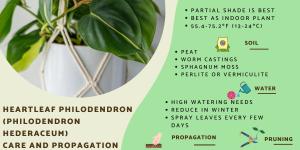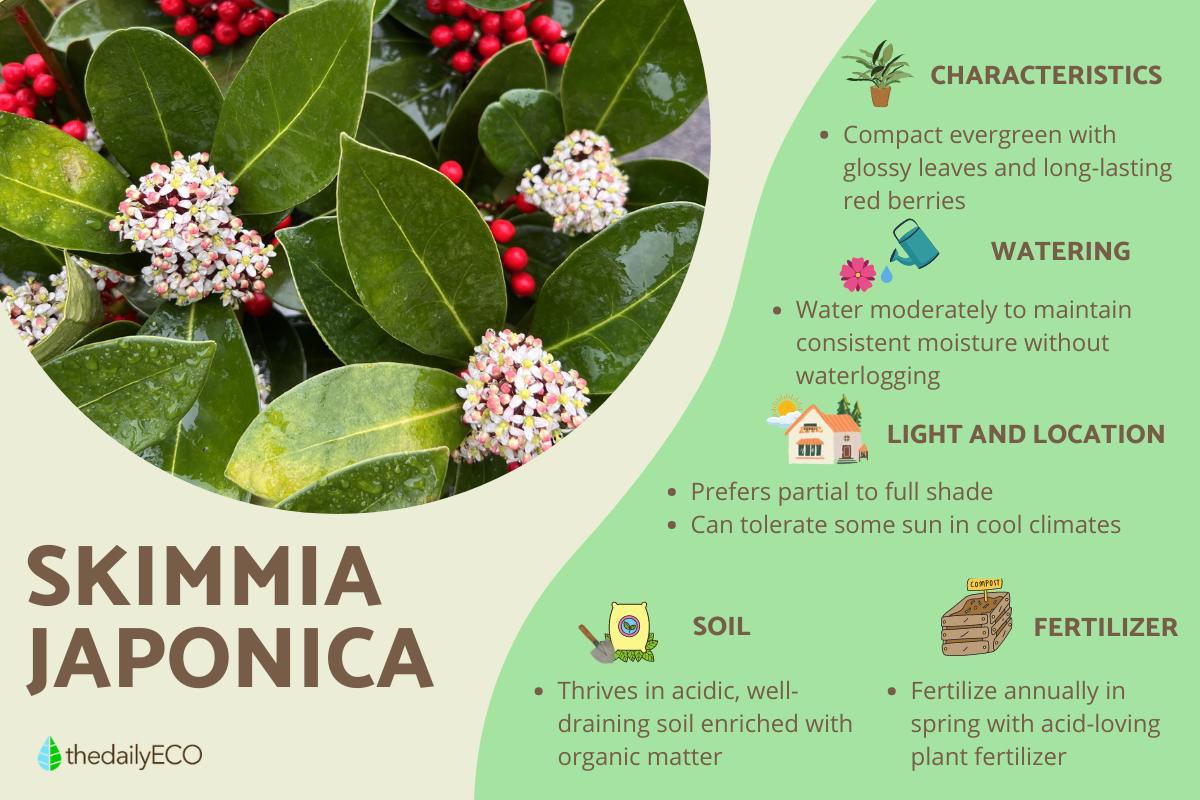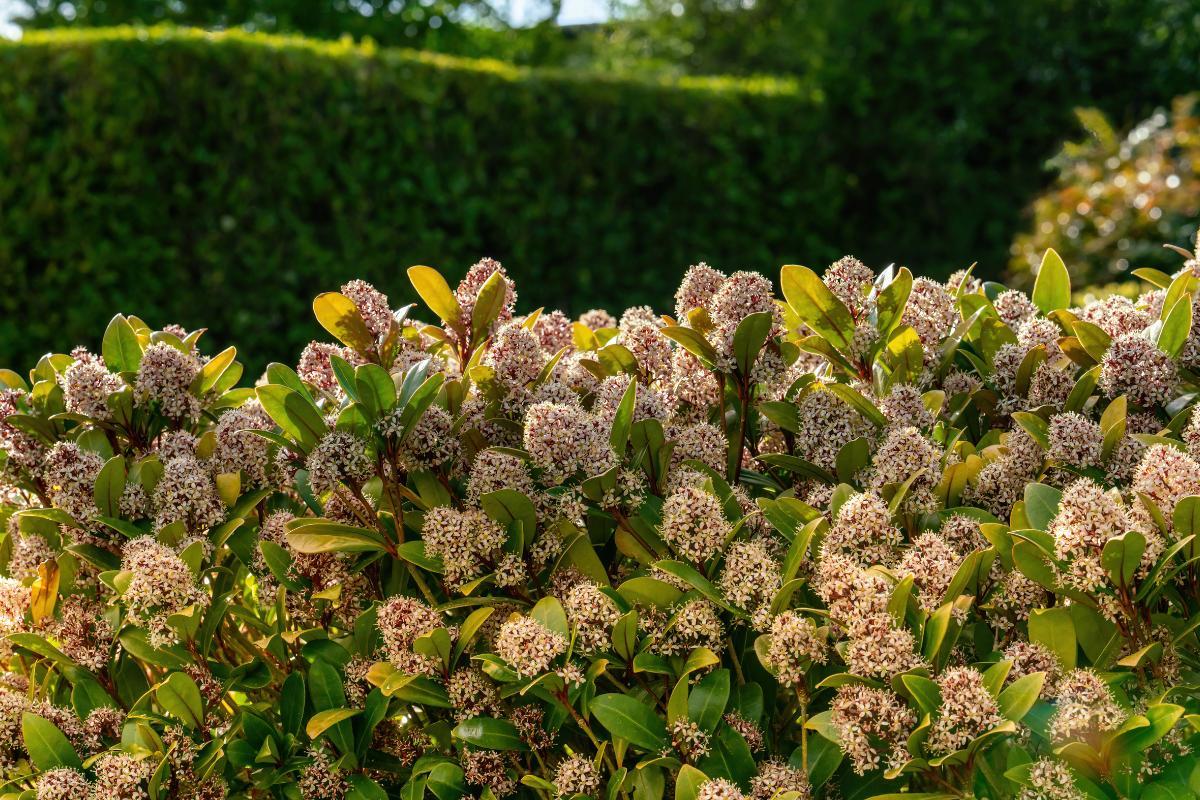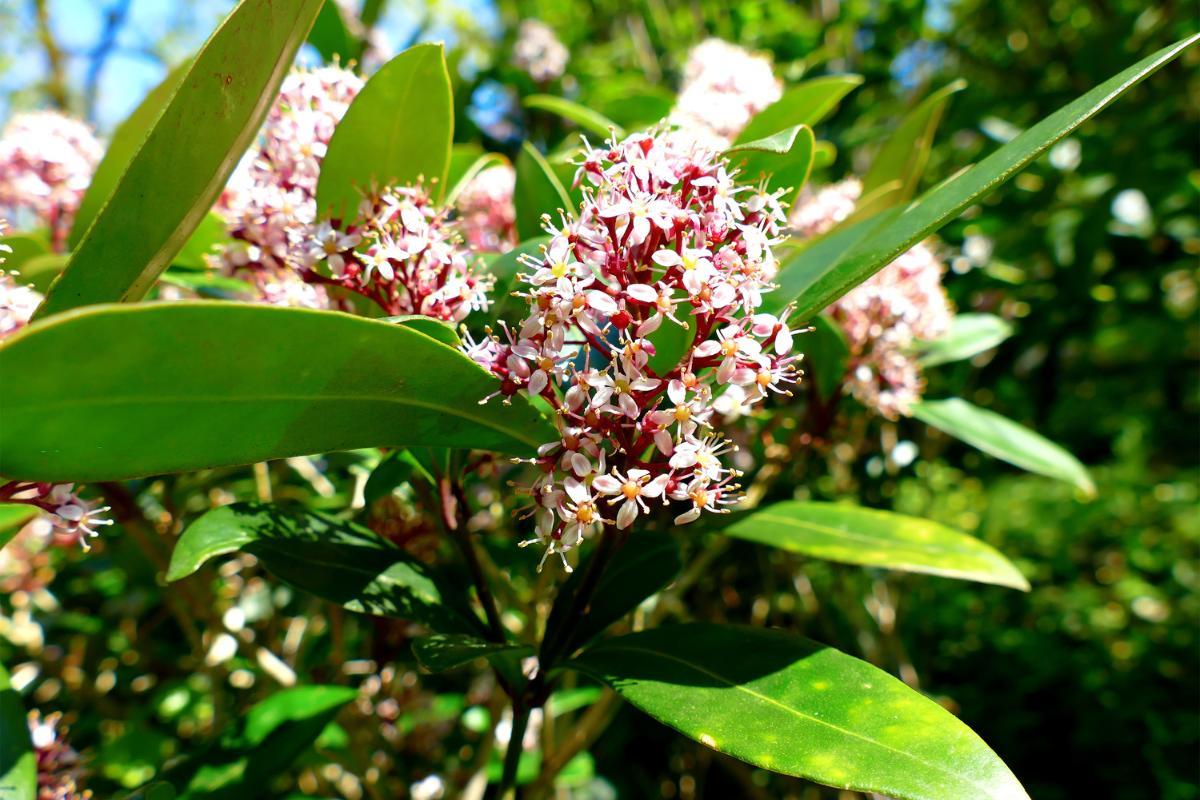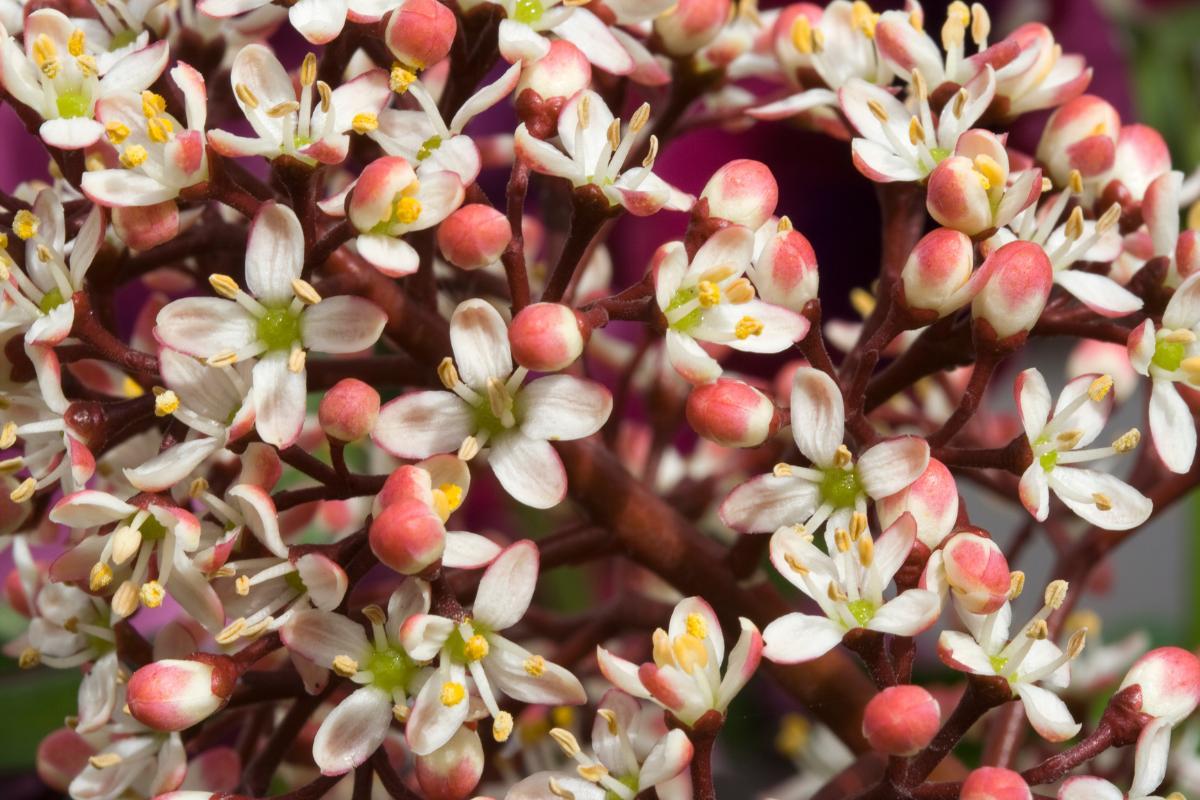Skimmia Japonica Care Guide

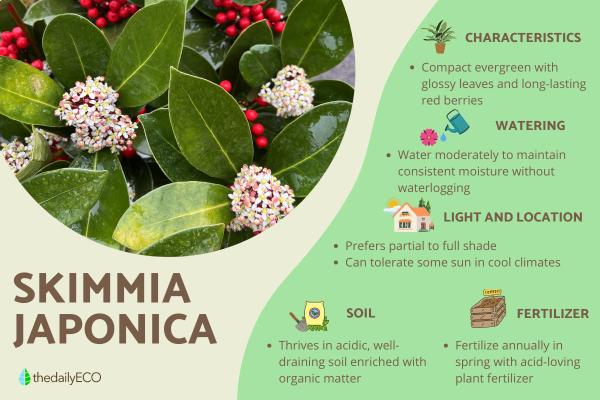
Skimmia japonica, with its glossy evergreen leaves and vibrant berries, brings year-round interest to the garden. This versatile shrub, hailing from the woodlands of Asia, offers more than just good looks; it's a resilient and relatively low-maintenance addition that thrives in a variety of conditions.
In this guide by thedailyECO, we'll explore how to grow Skimmia japonica, the best soil and light conditions, watering requirements, and how to identify and treat common plant diseases.
Characteristics of Skimmia japonica
Skimmia japonica is an attractive shrub prized for its vibrant red berries (about 8mm in diameter) that appear in summer and persist through winter. These decorative berries add welcome color during seasons when few plants flower, but are strictly ornamental and should never be consumed as they can be toxic to the heart. Let us take a look at some of the most distinctive characteristics of this plant:
- The plant forms a dome-shaped bush with abundant, aromatic foliage featuring glossy, lance-shaped leaves.
- It remains evergreen year-round, maintaining its attractive appearance in all seasons.
- Skimmia is compact, typically growing no taller than 1.5 meters (about 5 feet).
- In spring, the shrub produces clusters of small white flowers with subtle pink undertones.
- Skimmia is dioecious, meaning male and female flowers grow on separate plants. Male flowers are larger with a strong, sweet fragrance, while female flowers are smaller.
- Female plants will only produce berries if pollinated, so you'll need both male and female specimens in your garden to enjoy the decorative fruits.
- It's deer-resistant, adding to its appeal for gardens in areas with high deer populations.
- Skimmia is relatively pest and disease-free, adding to its ease of care.
- It works well as a foundation planting, in containers, or as part of mixed shrub borders.
- The plant has good pollution tolerance, making it suitable for urban gardens.
Looking to add vertical interest to your garden? Discover stunning options for bringing color to your garden walls and trellises in our guide to flowering climbers.
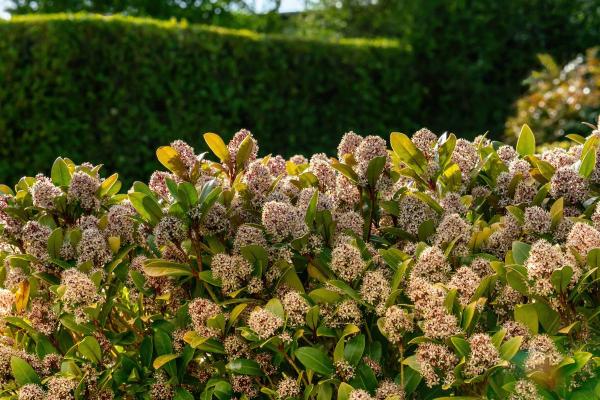
Best light conditions for skimmia japonica
Skimmia thrives in partial to full shade, making it perfect for adding visual interest to shadier parts of the garden where many flowering or fruiting ornamentals struggle. It works beautifully when planted under balconies, near entryways, or as an understory planting beneath trees.
The plant can handle full sun exposure in cooler climates where summer heat isn't extreme. If you notice the leaves developing white patches, it's a sign of sun damage and indicates the plant should be relocated to a more sheltered spot.
Skimmia is quite cold-hardy, but during snowy weather, it benefits from protective mulch, especially around the root zone. Without this protection, the leaves may suffer cold damage and appear burnt.
Perfect soil mix for skimmia japonica
Skimmia performs best in rich organic, well-draining soil with acidic conditions. You can create an ideal growing medium at home by combining equal amounts of peat and worm castings, then adding a handful of perlite to improve drainage and some elemental sulfur to lower the pH.
Covering the soil with pine needle mulch serves a dual purpose. On one hand, it gradually increases soil acidity while helping to maintain consistent moisture levels around the roots.

Proper watering techniques for skimmia japonica
Since Skimmia grows in shaded areas where water evaporates more slowly, it doesn't need frequent watering. However, the soil should remain consistently moist. Water moderately and regularly, being careful not to saturate the soil. Give just enough to maintain moisture without causing waterlogging.
If you've placed your Skimmia in full sun (though not ideal), you'll need to water much more frequently to prevent heat stress. However, this situation should generally be avoided as it creates unnecessary maintenance and may still stress the plant despite extra watering.
Spring pruning tips for skimmia japonica
Skimmia naturally maintains an attractive shape and doesn't require regular pruning. However, you can tidy up the plant by removing any stems that stick out awkwardly from the main form to keep it looking neat and healthy. If you choose to prune, spring is the ideal time to do so.
Propagating skimmia japonica
From seeds:
The simplest propagation method uses seeds from the plant's berries:
- Allow berries to fully ripen and dry, then extract the seeds.
- Plant seeds in fall in a worm castings soil mix, covering them with about 1 cm (½ inch) of soil.
- Water thoroughly and maintain consistent moisture without waterlogging.
From cuttings:
Alternatively, take cuttings in early spring:
- Select healthy young stems with leaves but no flowers (flowerless stems root more successfully).
- Use clean, sterilized tools to cut just below a node.
- Remove the lower leaves, keeping only those at the top.
- For better results, dip the cut end in rooting hormone.
- Plant the cutting in a pot with worm castings.
- Cover the pot with plastic to create a mini-greenhouse, but remove the covering twice weekly for about 10 minutes to provide air circulation. During these checks, remove any dead or decaying plant material.
- Keep well-watered for about 2 weeks until roots develop.
Ready to maximize your fall gardening efforts? Explore our curated selection of shrubs that thrive when planted during autumn's favorable conditions.
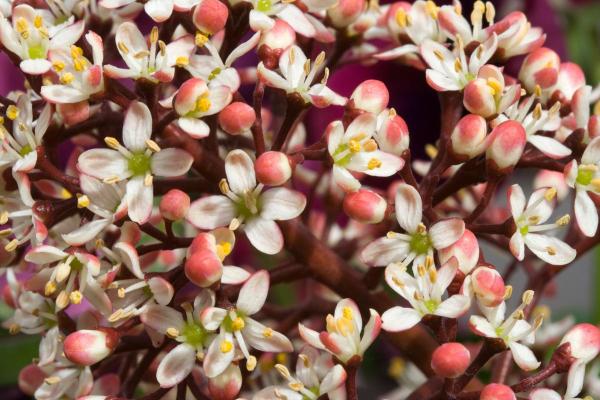
Common diseases affecting skimmia japonica
Skimmia is generally a robust, healthy plant that requires minimal maintenance once established. However, like most garden plants, it can occasionally encounter a few problems worth knowing about.
- Armillaria root rot: this fungal disease attacks the bark, appearing as white powdery growth beneath the outer bark layer or as mushroom-like structures growing at the plant's base. Installing a plastic root barrier can help prevent its spread.
- Phytophthora root rot: signs include yellowing leaves, sparse foliage, and dying branches. The best prevention is well-draining soil that doesn't remain waterlogged.
- Scale insects: these small, dome-shaped insects attach themselves to leaves and stems, where they feed on plant sap and gradually weaken the plant. They can be carefully removed by hand.
- Weevils: large brownish beetles that chew noticeable holes in leaves and can also damage roots. Control methods include hand-picking the insects or placing sticky traps near the plants to catch them.
Fortunately, with proper growing conditions, Skimmia typically stays healthy and resilient against these occasional challenges.
If you want to read similar articles to Skimmia Japonica Care Guide, we recommend you visit our Plant care and cultivation category.
- Royal Horticultural Society (n.d.) Skimmia japonica . Available from: https://www.rhs.org.uk/plants/17401/skimmia-japonica/details
- New York Botanical Garden (sf) Skimmia japonica search. Available at: https://www.nybg.org/search/?q=skimmia+japonica&x=0&y=0
- Bales, S. (2007). The Garden in Winter: Plant for Beauty and Interest in the Quiet Season. United States: Rodale Books.




